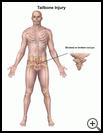
Tailbone Injuries
________________________________________________________________________
KEY POINTS
- Tailbone injuries are bruised or broken bones at the end of your lower back.
- Treatment may include using a doughnut cushion to keep pressure off of your tailbone. If you keep having symptoms, you may need steroid medicine or surgery.
________________________________________________________________________
What is a tailbone injury?
Tailbone injuries are bruised or broken bones at the end of your lower back. These bones are called the coccyx. Tailbone injuries are more common in women than in men.
A bruised tailbone may take several days to several weeks to heal. A fractured tailbone takes 4 to 6 weeks to heal. You may have pain for months to years after the injury.
What is the cause?
A tailbone injury may be caused by:
- A direct hit or fall onto the coccyx
- Childbirth
- Repeated strain or bumping of the tailbone, such as when rowing or riding a bike
What are the symptoms?
Symptoms may include:
- Pain when you are sitting
- Pain when you have a bowel movement
- Pain during sex or during menstrual periods in women
How is it diagnosed?
Your healthcare provider will ask about your symptoms and medical history and examine you. You may have X-rays.
How is it treated?
An injured tailbone needs time to heal. While it is healing:
- Buy a doughnut cushion to use when you are sitting. A doughnut cushion has a hole in the middle to keep your tailbone from touching your seat.
- Put an ice pack, gel pack, or package of frozen vegetables wrapped in a cloth on the injured area every 3 to 4 hours for up to 20 minutes at a time until the pain goes away.
- Take nonprescription pain medicine, such as acetaminophen, ibuprofen, or naproxen. Read the label and take as directed. Unless recommended by your healthcare provider, you should not take these medicines for more than 10 days.
- Nonsteroidal anti-inflammatory medicines (NSAIDs), such as ibuprofen, naproxen, and aspirin, may cause stomach bleeding and other problems. These risks increase with age.
- Acetaminophen may cause liver damage or other problems. Unless recommended by your provider, don't take more than 3000 milligrams (mg) in 24 hours. To make sure you don’t take too much, check other medicines you take to see if they also contain acetaminophen. Ask your provider if you need to avoid drinking alcohol while taking this medicine.
- Drink plenty of fluids and increase the amount of fiber in your diet to avoid constipation.
Rarely, if you keep having symptoms, your provider may:
- Inject the area with a steroid medicine so you will have less pain
- Recommend surgery
Follow your healthcare provider's instructions. Ask your provider:
- How and when you will get your test results
- How long it will take to recover
- If there are activities you should avoid and when you can return to your normal activities
- How to take care of yourself at home
- What symptoms or problems you should watch for and what to do if you have them
Make sure you know when you should come back for a checkup. Keep all appointments for provider visits or tests.

